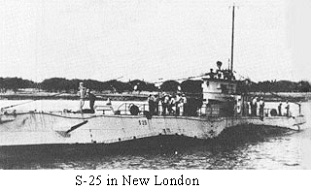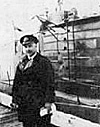
[formerly USS S-25] American S-Class submarine
Specifications
Length: 66.8m [219 ft. 3. in.]
Beam: 6.3 m [20 ft. 9 in.]
Draft: 4.9 m [16 ft.]
Power: [diesel] 1200 bhp, 2-shaft NLSE diesel engines
Power: [electric] 1500 shp, 2-Ridgeway electric motors
Speed: [diesel] 14.5 knots
Speed: [electric] 11 knots
Tubes: [bow] four 21-inch, [carried 12 torpedoes]
Guns: 1- 4-inch deck gun, 2 machine guns
Depth of dive: 60 m [200 ft.]
Crew: 35 men [4 officers]
ORP JASTRZAB was an American submarine loaned to the British through Lend-Lease. Because of a shortage of trained crews the British loaned the sub to the Polish Navy. ORP WILK supplied the crew cadre for JASTRZAB.
First U.S. skipper was Lt. Cmdr. George H. Fort. First and only Polish skipper was Kpt. Mar. Boleslaw Romanowski, who came from ORP WILK where he was the watch commander that claimed WILK struck a U-boat. [See story of ORP WILK]
(note – photos courtesy polishnavy.prv.pl)
Built by: Fore River Shipbuilding Corp.
Keel Laid: 26 October 1918
Launched: 29 May 1920
Commissioned: 9 July 1923
Sponsor: Rear Admiral R.S. Edwards USN and Miss Helena Strakacz [daughter of the Polish Consul, New York]
Sunk: 2 May 1942
Sunk by: Friendly Fire
Location sunk: Off coast of Norway
Position sunk: 71°30 N 12°32 E (5 men killed)
On 4 November 1941, in New London, Conn. the home of the U.S. Submarine fleet, the Polish ensign was hoisted on the old American sub S-25 and was renamed ORP JASTRZAB [P-551]. JASTRZAB sailed to St. John’s, Newfoundland staying there until 21 November. JASTRZAB then made for Holly Loch, Scotland in the company of the British crewed submarine P.511.
Crossing the North Atlantic in late fall, the subs were constantly battered by storms and heavy seas. On his first night’s watch, the CO stopped wearing a lifejacket, realizing that if swept overboard there would be no chance of rescue in the heavy swells. The sub had to dive to 90 feet before the boat stopped reeling. JASTRZAB arrived at Holly Loch on 1 December 1941.
During the journey JASTRZAB and the British sub P-511 became separated. Nothing was heard from the British sub until it was found wrecked on the rocks in the Orkney Islands. JASTRZAB remained at Holly Loch until the end of the year undergoing repairs and upgrades. JASTRZAB was then ordered to Rosyth, Scotland on the North Sea.
JASTRZAB left Rosyth on 22 April 1942; its mission was to protect convoy PQ-15 bound for Murmansk. The convoy gathered near the Shetland Islands. JASTRZAB’s mission was to cover the southern flank of the convoy. Allied submarines were used to act as a screen against German warships based in Norway. JASTRZAB stayed submerged as much as possible to avoid storms and heavy swells.
 Lt. Cmdr Romanowski
Lt. Cmdr Romanowski
On 2 May, while submerged, the sonar operator reported a contact. The CO raised periscope and saw a small trawler and an old American four stack destroyer bearing directly at JASTRZAB at full speed. The CO shouted to the crew to prepare to be depth charged. Seconds later the crew heard what sounded like a train rolling over the sub followed by explosions and the breaking of pipes, popping of rivets with jets of water coming through the hull. The CO decided to stay submerged until the second ship dropped its depth charges then surfaced before the second ship turned to continue its attack.
By ordering full speed the CO managed to avoid the depth charges of the second attacking ship. Immediately after the explosions the CO ordered JASTRZAB to surface with a signalman and an Aldis lamp to be first on deck.
As soon as the sub surfaced the signalman opened the hatch and reached the bridge. He was killed by ‘friendly’ machine gun fire. The CO who followed the signalman was also hit and wounded. Both ships were now firing at JASTRZAB with their deck guns, with the destroyer bearing down, intending to ram the sub. The CO, although wounded, saw what was happening and ordered the crew to abandon ship.
The crew began coming on deck through all available hatches, the whole time lighting recognition flares and using Aldis lamps. A Polish flag was displayed and the firing stopped. It was silent except for the sound of the wounded. The destroyer came alongside the sub and a voice shouted, ‘Are you German?’
The CO shouted back, ‘I am a Polish submarine, you bloody fool, can’t you see P-551? [P-551 was the conning tower ID number.]
The destroyer responded, ‘What can we do to help?’
‘Send a doctor and engineers,’ was the answer.
The two Allied warships were HMS SEAGULL and the Norwegian crewed destroyer SAINT ALBANS. Engineers brought over by launch decided JASTRZAB could not be saved. The crew abandoned the sub and were brought aboard the two ships. Five crewmembers were killed and about fifteen were wounded.
The ordeal of the crew was not yet over, as they continued on to Murmansk aboard the two ships which returned to escort duties for the convoy. The two ships endured German air attacks and carried out depth-charge attacks until reaching Murmansk where the Poles transferred to the Polish destroyer ORP GARLAND. [HMS SEAGULL was sunk on the return trip to England.] ORP GARLAND was seriously damaged from air attacks while escorting PQ-16, sustaining twenty-five killed and forty wounded. The men from JASTRZAB were needed to help crew the destroyer for the return trip.
After an uneventful return trip, a Royal Naval Board was convened on the loss of JASTRZAB. It was determined that the Polish submarine was outside its patrol area due to a navigation error. Although the Allied warships may have been justified in the attacking, they were found to be negligent in ignoring the recognition flares.
In one of the many ironies of war, this situation in particular, was that some of the wounded crewmen of ORP GARLAND and ORP JASTRZAB had only recently been released from Soviet Gulags after 2 years of maltreatment and imprisonment. Now these same men were being treated in Soviet hospitals after being wounded bringing supplies to a former enemy.
DAVID, another excellent piece of research – many thanks. to our other Members, we’d enjoy your research articles. Make sure they are accurate and if possible, include photos. Thanks in advance.
Back to KTB # 175 Table of Contents
Back to KTB List of Issues
Back to MagWeb Master Magazine List
© Copyright 2004 by Harry Cooper, Sharkhunters International, Inc.
This article appears in MagWeb.com (Magazine Web) on the Internet World Wide Web. Other articles from military history and related magazines are available at http://www.magweb.com
Join Sharkhunters International, Inc.: PO Box 1539, Hernando, FL 34442, ph: 352-637-2917, fax: 352-637-6289, www.sharkhunters.com
